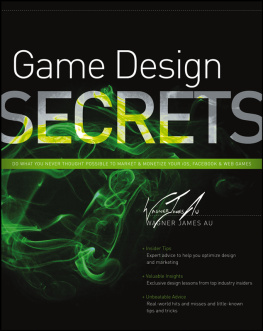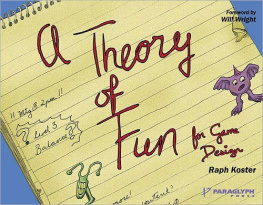

Great Clarendon Street, Oxford, OX2 6DP,
United Kingdom
Oxford University Press is a department of the University of Oxford. It furthers the Universitys objective of excellence in research, scholarship, and education by publishing worldwide. Oxford is a registered trade mark of Oxford University Press in the UK and in certain other countries
Samantha Stahlke and Pejman Mirza-Babaei 2022
The moral rights of the authors have been asserted
Impression: 1
All rights reserved. No part of this publication may be reproduced, stored in a retrieval system, or transmitted, in any form or by any means, without the prior permission in writing of Oxford University Press, or as expressly permitted by law, by licence or under terms agreed with the appropriate reprographics rights organization. Enquiries concerning reproduction outside the scope of the above should be sent to the Rights Department, Oxford University Press, at the address above
You must not circulate this work in any other form and you must impose this same condition on any acquirer
Published in the United States of America by Oxford University Press
198 Madison Avenue, New York, NY 10016, United States of America
British Library Cataloguing in Publication Data
Data available
Library of Congress Control Number: 2022937904
ISBN 9780198845911
DOI: 10.1093/oso/9780198845911.001.0001
Printed and bound by
CPI Group (UK) Ltd, Croydon, CR0 4YY
Cover image: Samantha Stahlke
Links to third party websites are provided by Oxford in good faith and for information only. Oxford disclaims any responsibility for the materials contained in any third party website referenced in this work.
For our families
(Yes, that means you too, Svetlana)
Foreword
When someone first explained to me that UX design in game development was shorthand for User eXperience design, my instinctive reply was, So, you mean game design?
I dont remember clearly how the exchange went after that. Probably they shook their head, cleared their throat, and fidgeted, politely working around my awkward naivete to explain the subtle distinctions we normally point to in methodology and purpose. Upon reflection, I believe what they should have said was, Yes, in the same way that when I say biology, I also am talking about science.
I am a game designer, but in a smaller team, that often means I also contribute to the game and studio in many other ways. Writer, business developer, product manager, level designer, system designer, producer, quality assurance, localization coordinator, casting director, and of course UX designer. I write of course because there are very few methods of achieving good game design without (consciously or unconsciously) executing good UX and interaction design.
Understanding the user experience is the fundamental requirement for understanding how and why a game worksmechanically, aesthetically, emotionally, artistically. Some designers shuffle towards creating their desired experience more instinctively, with pure trial and error, embracing iteration without considering how analysis might save them time and effort. But the best designers I know employ a vast vocabulary with a wide array of tools, all striving to somehow peer through the plastics and metals of the physical artifacts, strip away the clouding of vaguely-worded feedback, and clearly perceive the players true experience. They see not only the players mental state, but the dynamic shifts it undergoes while playing, and all the many intricate variables that contribute to those transformations.
In the early days of Kitfox, while we were still part of Execution Labs, I was introduced to Pejman, as the UX Research Director who offered insights and support to all of the teams there. More recently, Samantha and Pejman were able to provide research resources to analyze how players responded to Boyfriend Dungeons characters, increasing our confidence in writing and character design. The game undoubtedly owes some portion of its success to their team.
When I heard they were writing this book, I knew Id want to read it as soon as possible. I wish I had been able to take advantage of the lessons and best practices described in this book for my entire career, but Im glad I can start now! Im envious of all the young designers who can tuck this into their toolbox immediately and have that much more to work with as they begin their craft.
To the designer holding this book in your hand right now, I wish that it brings you courage and good fortune. The user experience is often a hydra of a problem, with every curiosity replaced by two more in its exploration. I believe this book can help all of us game designers decide which questions are worth asking, and benefit more from the knowledge they expose. They say there is no such thing as a finished piece of art, only that which has been abandoned but equally, perhaps there is no such thing as a complete understanding of user experience, only those questions we are brave enough to ask.
Be brave.
Good luck.
Tanya X. Short
Preface and Acknowledgments
We decided to write this book for many different reasons. A desire to share what weve learned about game interaction design with aspiring designers around the world. Wanting to create an educational resource that could reach beyond our own students. A frustration with the dearth of textbooks containing puns and edgy takes on the gaming industry that no one asked for. Most importantly, we decided to write this book to share our passion for games and what makes them tick with a diverse audience. No matter whether youre a student of design, a curious gamer, or a professional on the hunt for puns and edgy takes, we hope this book can provide you with some useful knowledge, helpful examples, and inspiration for your own work.
If youre wondering why we decided to write this book, the long version of that story includes an ill-fated midterm exam, a few oddball research projects, and several bowls of ramen. The short version of that story is that the we in question, Samantha and Pejman, have been working together since 2015 in both academic and commercial work. After co-authoring several articles together and collaborating in a few teaching endeavours, Pejman suggested that they write a book about game interaction design. Samantha agreed with this idea, because she has poor impulse control. And, after a few years of writing, interviews, writing, editing, writing, compositing, and writing, youre about to (hopefully) delight in the result of that collaboration.
Creating this book has been both a challenging and rewarding journey. When we set out to write it, we knew that it would be difficult to pull together a volume that managed to capture our combined advice on game interaction design while also teaching and working on our research. What we didnt anticipate was that most of our writing would end up taking place during the pandemic lockdowns, which made the effort overwhelming at times. Luckily, we are fortunate to have the most wonderful, understanding friends and family that anyone could hope to imagine. There are many people who have supported us through this journey, and this book would not have happened without their support.
We would like to thank Dan Taber, our Commissioning Editor at Oxford University Press, and his team, particularly John Smallman, Katherine Ward and Charles Bath, for guiding and encouraging us from the initial discussion we had about this book all the way to final release.
Next page
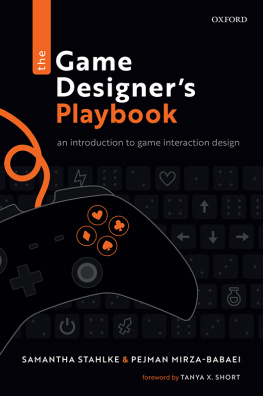

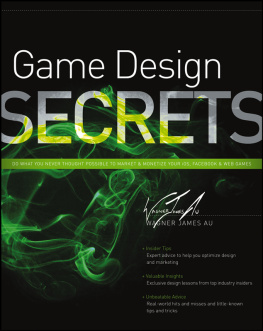
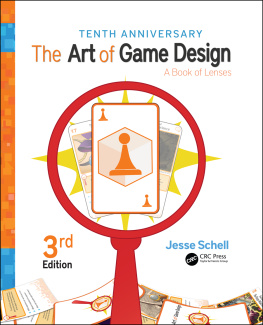
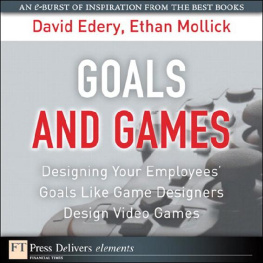
![Jesse Schell [Jesse Schell] - The Art of Game Design, 2nd Edition](/uploads/posts/book/119435/thumbs/jesse-schell-jesse-schell-the-art-of-game.jpg)
![Wagner James Au [Wagner James Au] - Game Design Secrets](/uploads/posts/book/119431/thumbs/wagner-james-au-wagner-james-au-game-design.jpg)
![Ethan Ham [Ethan Ham] - Tabletop Game Design for Video Game Designers](/uploads/posts/book/119417/thumbs/ethan-ham-ethan-ham-tabletop-game-design-for.jpg)
